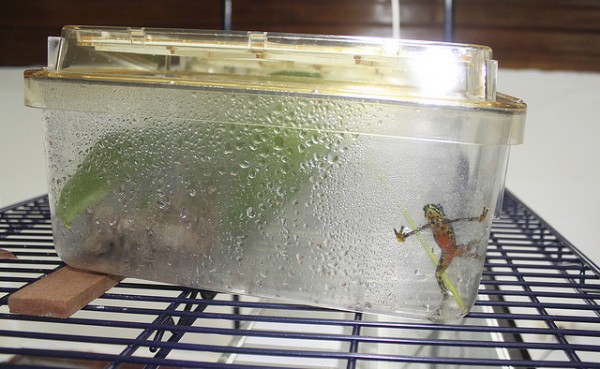For students aged 10-15
Introduction:
Amphibians can be distinguished from all other groups of vertebrates by their soft, moist skin. Amphibian skin is very porous/permeable, and they use their skin to exchange water, salts and air with the environment, much more so than other vertebrates (reptiles, birds, and mammals) do. If an amphibian’s skin dries out, it no longer functions properly and the animal can die. The amphibian chytrid fungus is a disease that is attacking frogs and toads worldwide and affects the skin of amphibians, making it less permeable to water, salts and air
Materials: Per student pair: 3 cups, one piece of aluminum foil, one paper towel, one paper towel covered with dried glue, one spray bottle, water, 3 rubber bands, “Skin They’re In” Worksheet
Day before doing the activity: The instructor should prepare for each group a piece of paper towel. Prepare the paper towel by stretching it across the top of a cup and securing it with a rubber band. Then spread a thin layer of white school glue over it and allowing it to dry over night. If you like, mix a bit off food coloring into the glue so the students can see it when it dries.
Procedure:
- Give each group 2 cups, 2 rubber bands, a piece of aluminum foil, and a piece of paper towel. Allow them to spend a few minutes touching each of the materials before stretching one across the top of each cup and securing it with a rubber band. Ask students to make predictions on the lab sheet (following page). Discuss: Which material do you think water will pass through most like amphibian skin?
- Have students spray water on each of the materials. Ask them to count each time they spray. On the data sheet, have students record how many sprays are necessary before the water begins to drip though to the bottom of the cup. If no water has dripped after 25 sprays they can assume that it will not pass through and record that the material is impermeable. Challenge students to analyze your data and report their findings.
- Provide the students with the 3rd cup, which has the paper towel with a layer of glue in it. Ask them to touch it, and compare it to the other paper towel. Ask them to hypothesize whether or not it is s permeable as the other paper towel, and then allow them to spray water on it and observe what happens. After they finish the experiment explain how now the frogs “skin” is thicker and tougher, and water/air won’t penetrate as easily. This is the same effect that the chytrid fungus has on amphibians, causing them to dehydrate, suffocate, and die.
Amphibian conservationists take care to keep amphibian chytrid fungus out of the amphibian ark. Frogs brought into captivity are kept in a separate room called quarantine where they are treated with antifungal medicine. After 30 days the frogs are tested for chytrid fungus and if they are negative, they can enter the amphibian ark. We use a new pair of gloves each time we touch a frog to prevent spreading the disease from frog to frog by human contact. We use special filters to remove chytrid fungus and other harmful chemicals from the water we use. We are also searching for a cure for chytrid fungus so that frogs can be reintroduced to the wild. Don’t be a disease vector! If you have been out getting muddy in the stream or pods, you should wash your shoes or boots with very hot water or bleach solution to kill any chytrid spores that may be living in the mud before going to a different stream or pond. You don’t want to be responsible for spreading this disease!

